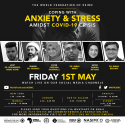LIVE shows will broadcast here. Click here to watch the live show during these times. NEXT Date: Sunday 26th April 2020. Time: 1:30-3:00 PM New York, 6:30- 8:00 PM London, 8:30-10:00 PM Dar Es Salaam, 10:30-12:00 AM Karachi, 11:00 - 12:30 AM Mumbai, 3:30 - 5:00 AM SYDNEY.
For many, their relationship with cultural heritage shifts and changes over time. For others, they feel a constant and strong connection to their cultural heritage. The question is, what is it about cultural heritage that draws people to it? When people feel distant, why are they drawn back?
Studies show cultural heritage can provide a robust range of benefits. It can help people feel connected to a shared set of social values, customs, and beliefs. It allows them to reinforce their identity and strengthen a sense of belonging. In essence, it has the scope to provide an automatic sense of unity within a group, allowing for a richer understanding of origin and history.
There have been countless papers, articles and coffee discussions on the purpose of our being. And this is often linked to a greater understanding of where we came from, in order to achieve where we need to be. On an individual level, understanding our cultural heritage and histories can feel like a doorway to understanding the lives of generations gone, and the horizon of our own lives and purposes. With the hope that the journey of a collective people, provides insight into journeys to come.
On a macro level, communities centered around cultural heritage provide a base for communal support. An ever growing problem in large cities is a sense of feeling alone and lost. Collective growth and strength within communities based on cultural heritage are often a wonderful resource of support and assistance. Perhaps this is part of the natural draw back to cultural heritage; an unrecognised need for safety and belonging.
Cultural heritage is made up of many things – we see it in landscapes, architecture, books, clothing, photographs, food, art and tradition.
They help form a picture of where we came from, the hardships and joys people went through, the struggles they overcame, and the strength they developed. And perhaps simply, their journeys are an inspiration to each new generation when the same questions of purpose, intention and identity arise. It doesn’t have to be an understanding of who we are based on where we came from, but rather who we want to be.
Collating and documenting these histories are essential and necessary.
The great work of The Khoja Heritage programme aims to do just this.
And it's quite invaluable.
[This is the second in a series of reflections by Sister Fatema Zehra Bandali. Click here to read part three. If you missed the first in the series, you can read this here. For more information on the conference please visit http://khojastudies.org]
Related News
Related News
Read the full message from Shabbar Dhalla, Vice President of The World Federation.












